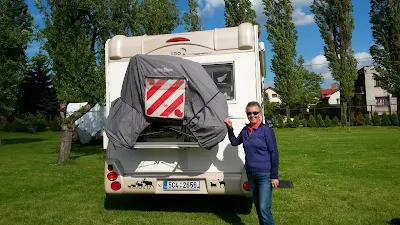 |
| Bochnia Salt mine-Marg |
Leaving Kraków, we drove through more small
villages and communes until we reached the town of Bochnia which has the
Kopalnia Soli – Poland’s most ancient salt mine.
This mine has been worked from the Middle Ages
until the present day.
 |
| Tarnów-Marg & Vanni |
We descended the main mine shaft in a noisy, small
and very quick (eek!) lift to the mine workings.
There, we had a short train ride to a series of
exhibition tunnels, chambers and chapel which had some wonderful sculptures.
It was a very interesting visit in an authentic
mine.
 |
| Tarnow Rynek-Marg |
Later, we drove to Tarnów (pronounced tarnuf), and
after following some slightly confusing camping signs we found our campsite.
It was in the grounds of an attractive hotel just
on the edge of town.
There was just us and a Swiss couple in their van, so it
was very peaceful.
 |
| Tarnow-Gypsy celebration |
It was an easy walk to Tarnów’s medieval old town
which was marked by a circular street of cobble stones flanked by historic
homes and shops.
This street went right around the old part of the
city, and included parts of the old town wall.
The rynek (market square) had a very solid looking
town hall in the centre.
 |
| Zalpie painted houses |
During our walk around, we found the regional
museum.
Popping in there, we happened upon a display of Gypsy culture and a
celebration of Gypsy life in the area.
It was great to see original and colourful
‘campervans’, old and young people dancing, and the culture being celebrated.
We felt privileged to be there.
On the way back to camp we stopped off at the
nearby park which had a Health and Wellbeing festival going on.
There was a good crowd of locals enjoying watching
children on stage, along with lots of displays and food stalls.
Again, lovely
to see the local activities and celebrations first hand.
The drive out of Tarnów took us to Zalipie. This is
a tiny village famous for art traditions and its floral painted houses.
Since the late 19th century the local women have
been painting their houses inside and out with bright, floral patterns that are
quite stunning.
 |
| Binarowa Wooden Church |
We visited one of the old houses and every bit of
furniture, the chimney and all the utensils were painted in the unique floral
pattern.
We then moved on along a route of ancient wooden
churches, stopping to see a number of them.
Some were closed but we were able to get inside the
UNESCO listed one at Binarowa to see the most beautiful and very old frescos
covering the walls and ceilings.
A lot of the old wooden churches are still being
used by their local villagers for worship.
Getting to these churches involved a lot of driving
over very narrow and bumpy roads, and avoiding cyclists and chooks which were
all a little challenging!
We were going to stop in Rzeszów (pronounced
jshezuf) for the night, but it proved to be rather industrial so we continued
on to a camp in a little place called Pastewnik.
We were so tired after so much driving that we
succumbed to dining in their restaurant.
 |
| Haczow Wooden Church |
Great ‘real’ steaks and a locally brewed beer
revived us!
The rain really set in that night so we decided to
move on to Zamość (pronounced zamoshtsh) the next day.
 |
| Zamosc Rynek-Leigh |
Luckily the weather brightened up a bit for
driving; unluckily the roads we chose to go on had big holes filled with rain
water, which made for a tiring drive.
Our Zamość campsite was basic but had a nice green
outlook and short walk to the old town so that was OK.
The Zamość stare miasto (old town) is centred on an
open square - the rynek. The square is surrounded by very attractive buildings
with a colonnaded walkway underneath.
There was a very impressive town hall and we
managed to get a tour of its underground rooms.
Our guide George, shared an amazing range of
interesting facts of local Polish history and the fascinating past of this
attractive UNESCO town.
The town was originally fully fortified with huge
walls and a moat and swamp. It has seven bastions at strategic points and
remnants of these are clearly visible and parts are restored to show the extent
of them. It was very interesting.
We found Zamość to be a very compact town and
extremely easy to walk around. It was also a great place to take a break before
moving on to Ukraine.
We topped up one of our gas bottles there and the
man doing the filling was so excited and amazed that we were from New Zealand
or Nowa Zelandia, as they say here.
They all seem to know about us as country which is
quite amazing and pleasing for us proud Kiwi’s.